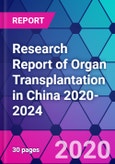Human organ transplantation in China began to be performed in the 1960s and grew more mature in 1990s. The number of organ transplants kept increasing and the survival rates of patients and grafts rose significantly.
The annual number of organ transplants in China increased from 5,000 many years ago to more than 20,000 in 2018. Able to transplant livers, kidneys, hearts, lungs, small intestines and perform simultaneous pancreas-kidney transplants and multiple-organ transplants, China became the country second only to the United States in terms of the number of organ transplants, and is expected to become the country with the largest number of organ transplants in 2020. The increasing number of organ transplants in China greatly expands the market of immunosuppressive drugs that organ transplant recipients need to take for life.
With wider clinical application of new immunosuppressant, the market size of immunosuppressants in China exceeded CNY 15 billion in 2018.
Since the Chinese government announced the suspension of using the organs of condemned prisoners for organ transplantation in 2015, organ donation became the only legal source of supply. However, affected by traditional mind, most Chinese people are reluctant to donate their organs. The undersupply of transplant organs cannot be addressed in the short term, which creates a breeding ground for the black-market trade in organs.
According to market research, although facing challenges, the annual number of organ transplantation is estimated to be more than 40 thousand according to the publisher, and the market of immunosuppressants is expected to be over CNY 30 billion by 2024.
Topics Covered:
- Introduction
- Development Environment
- Development Status in China
- Relevant Market
- Prospect of China's Organ Transplant Industry
Table of Contents
Methodology
Background research defines the range of products and industries, which proposes the key points of the research. Proper classification will help clients understand the industry and products in the report.
Secondhand material research is a necessary way to push the project into fast progress. The analyst always chooses the data source carefully. Most secondhand data they quote is sourced from an authority in a specific industry or public data source from governments, industrial associations, etc. For some new or niche fields, they also "double-check" data sources and logics before they show them to clients.
Primary research is the key to solve questions, which largely influence the research outputs. The analyst may use methods like mathematics, logical reasoning, scenario thinking, to confirm key data and make the data credible.
The data model is an important analysis method. Calculating through data models with different factors weights can guarantee the outputs objective.
The analyst optimizes the following methods and steps in executing research projects and also forms many special information gathering and processing methods.
1. Analyze the life cycle of the industry to understand the development phase and space.
2. Grasp the key indexes evaluating the market to position clients in the market and formulate development plans
3. Economic, political, social and cultural factors
4. Competitors like a mirror that reflects the overall market and also market differences.
5. Inside and outside the industry, upstream and downstream of the industry chain, show inner competitions
6. Proper estimation of the future is good guidance for strategic planning.

LOADING...








